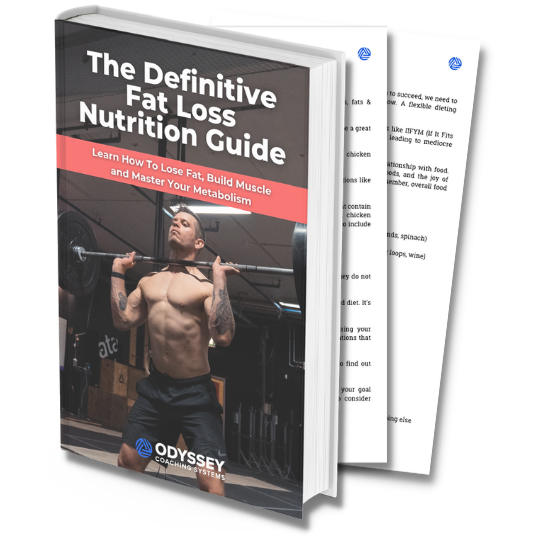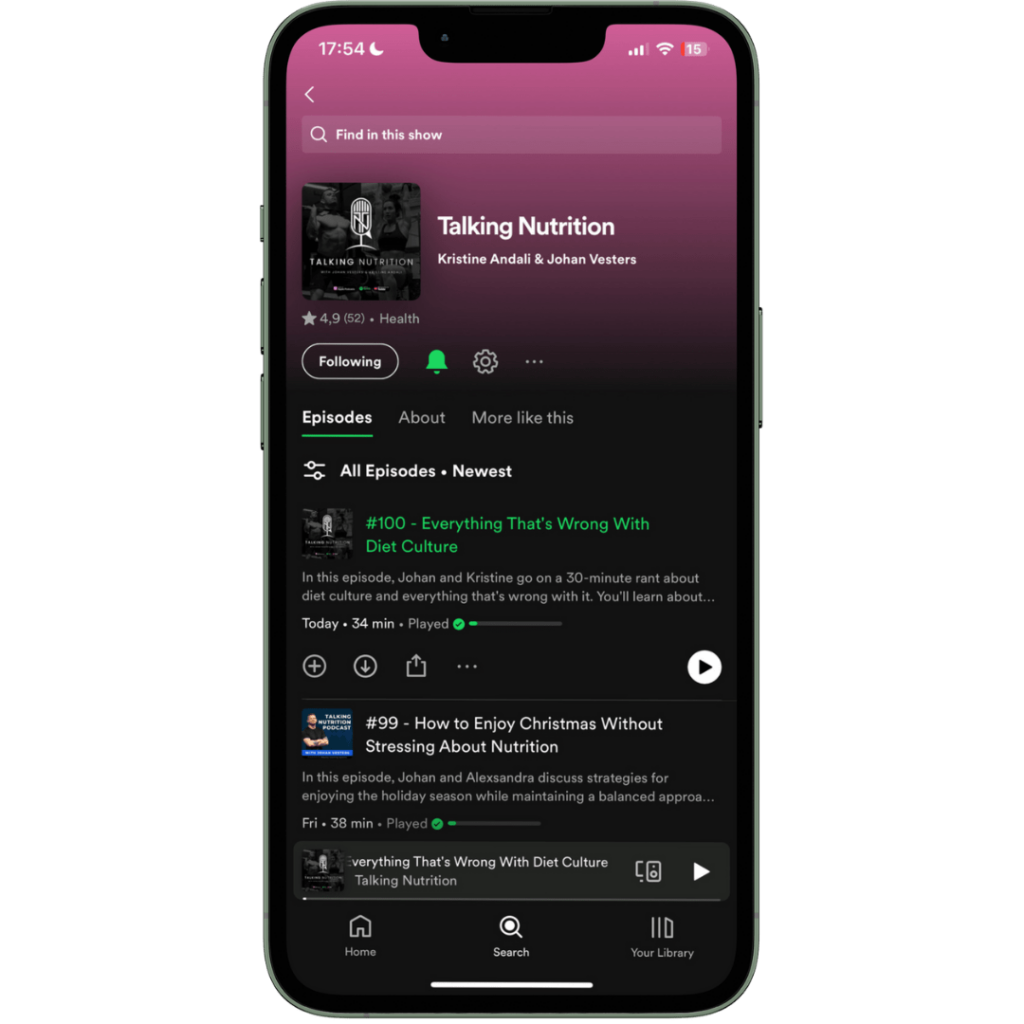Main Take-Aways
1. Tracking macros is the ultimate adherence and learning tool.
2. In my opinion almost everyone should try tracking macros for at least a little while to learn about flexible dieting and to go through dedicated muscle gain, fat loss, reverse, and maintenance phases.
3. If you give tracking an honest chance you’ll end up with more knowledge, improved portion control, better body composition changes, and the skill to do better without tracking after you’ve gone through the whole process.
When it comes to transforming your body and learning about nutrition, tracking macros helps you like no other.
While plate, hand portion, and intuitive approaches can work just fine to maintain weight loss, these usually come with a lot of guessing and won’t help you control your nutrition that well.
Because it’s the ultimate teaching tool, all of our online fat loss clients spend the majority of our collaboration tracking macros.
Tracking teaches you about portion control, shows you exactly what nutrients are in certain foods, and in contrary to common believe allows you to be MORE flexible with your nutrition
You also make sure that you don’t lose weight too fast (which is something most fad diets do wrong). Meaning you’ll lose fat effectively without unwanted muscle loss, next level hangry-ness, or risking weight regain.
You learn from tracking macros, so that you ultimately do better without it afterwards.
You can use it to your advantage, get results, then move away from it when it’s time. This is exactly how we incorporate tracking in our program, because it shouldn’t be forever.
Why do people have a negative experience with tracking macros?
You might’ve heard claims like “Tracking macros is obsessive” or “tracking leads to eating disorders“.
And hey, if you do struggle with an eating disorder, then please seek help from a professional. As much as I want to help you, treating eating disorders is outside of the scope of both my coaching practice, and this (or any other) blog.
For most people, tracking macros likely won’t cause you any problems at all.
It’s just a teaching tool. If you go in with a plan, an open mindset, and the right how-to you’ll be absolutely fine.
But that’s exactly where it goes wrong.
Most are not taught how to track properly, what to do, what not to do, and they don’t go in with a plan.
Here’s why some people struggle to track their macros and miss out on the unique learning experience.
Reason 1 – The learning curve
Quick analogy for you:
I remember when I bought a Norwegian keyboard for my laptop. I kept hitting the wrong keys over and over again.
For weeks on end I had to correct letters and symbols in about every sentence I wrote. I felt annoyed and frustrated.
Why? Because it was something new, something different from what I was used to.
Can you remember when you got your first smartphone? A new tv? Or when you tried to learn a new language?
Everything new comes with a bit of a learning curve, and tracking macros is no different. It just takes some getting used to.
Unfortunately most people give up tracking after one meal, one day, one week of not being able to get it perfect.
My first and most important tip for you is to just start trying. You will not master it right away, and that’s okay.
Give tracking macros a chance for at least 30 days before you go “this isn’t for me”.
Oh, and as for that Norwegian keyboard? It feels like second nature to me now.
Reason 2 – No one showed you how to track macros the right way
Did you know that it’s best to NOT follow an app’s macro or calorie recommendations? Especially if it lets you select how many kilos/pounds you want to lose per week?
You also might not know that it’s impossible to know how many calories you burn? Neither the app, nor your fitness tracker knows this.
Are you supposed to weigh your foods cooked or raw? And what about those percentages you see next to ‘protein, carbs, fats’?
While you certainly can figure it all out through trial and error..
Let me answer the do’s, don’t, and most common questions about tracking macros for you.
That way you don’t have to make all the mistakes I did when I tried tracking for the first time a decade ago.
Tracking macros: frequently asked questions
Is tracking macros accurate?
Yes and no. It’s the most accurate method to control your food intake. But understand that it is still not 100% accurate, which is ok.
It’s less about getting it down to the single gram or calorie (more on this in a bit), and more about being consistent with tracking (and so, consistent in your inaccuracies).
We’ll talk about how accurate you need to be in a bit.
Do you have to weigh everything?
It depends. When you’re at maintenance, probably not.
But if you’re working towards a fat loss or muscle gain goal, or you’re still in the learning phase, then I suggest weighing pretty much everything (within reason).
When you track, pay full attention, go all in on it for a while.
Being proactive about it will lead to better results, sooner. Plus you’ll learn more. Especially things like oil, peanut butter, etc. will quickly add up so make sure you log those.
The only exceptions here are fruits, vegetables, which can be logged as ‘1 small/medium/large X’ if you use Cronometer, and no-calorie drinks (unless you want to track your hydration too).
Counting macros vs calories. What’s better?
They both work. But if you go with calories I do suggest also tracking protein, the most important macronutrient. Because the carb/fat ratio does not seem to matter for fat loss, you’re free to stick to just that.
Our online nutrition coaching clients usually start off tracking calories and protein. This is slightly easier and shows me their preferred carb/fat ratio, which helps us make more personalized recommendations afterwards.
We then switch them over to macros once they’re ready to take it a step further. Tracking macros can help optimize your hormones, energy levels, stress levels, satiety, and more. So although both work fine, I usually suggest going with macros.
Side note: calories come from macronutrients and alcohol. Protein and carbs give you about 4 calories per gram, fats 9 calories per gram, and alcohol 7 calories per gram. So when you track your macros, you automatically track your calories.
When tracking macros is it net carbs?
Net carbs is the total amount of carbs you eat minus fiber. While you can track net carbs instead of total carbs, this is unnecessary and likely makes things more confusing.
Instead, just track your total carbs and aim for a fiber amount around 20-30g as your baseline.
Does tracking macros help lose weight?
It can. But it’s important to note that tracking is not a diet. It’s your measuring tool that you can use to lose weight if you want to, but also gain or maintain.
If you want to lose weight, you’ll have to be in a caloric deficit, which you can calculate here.
Many people will often see weight loss once they start tracking for the first time, because it’s the first time (in a while) they begin to control their intake.
More consistency in your food intake often leads to less overeating during the weekends.
When counting macros raw or cooked, how do I log it?
Foods can weigh up to 2-3x as much after cooking, which can be affected by how much water you use in some cases. For that it’s probably a good idea to track things raw/uncooked.
However what matters most here is that you consistently log stuff the same way. Choose either cooked or raw, and stick to it.
Is it true that food labels are incorrect?
Yes! The FDA allows for a 20% error rate on food labels (both ways). So the more packaged/processed foods you eat, the more inaccurate and inconsistent your macros will be.
That also means that although scanning food labels is convenient, you’re likely better off sticking to minimally processed stuff that doesn’t always come with a food label.
How do I track macros when eating out at a restaurant?
It depends on where you’re at in your journey and if you’re working towards any goals.
Some people do well with an untracked meal or day here and there. Others prefer tracking and/or might switch from macros to calories and protein.
Whatever you do. You do not need to bring a food scale or any prepped food to social settings.
Just eye-ball food amounts (this becomes easier with time), and log a food from the database that’s similar. Sticking to mostly minimally processed foods also makes this easier.
Close enough will do in this scenario. Just be aware that restaurants use more oil and butter, so your meal will be fattier than usual. And of course the more you go out, the more difficult it becomes to stay consistent.
Is it possible to gain muscle or lose fat without tracking macros?
It’s possible, yes.
Though one of the most important things you can control that leads to better results is your rate of weight gain/loss.
If you want to lose more fat and build more muscle, then tracking is probably your best bet.
What’s the best macro tracking app?
Cronometer, hands down.
There are so many different options in the database, how do I know which one is correct?
Some apps like MFP have huge databases with tons of incorrect entries, often added by users.
To keep things simple and as accurate as possible, our clients use the ‘common foods’ database in Cronometer.
All the data is double checked by their team, plus you’ll be able to find every ‘normal’ food (aka the minimally processed foods you should mostly eat anyway).
For how long should you track your food?
That depends. However long it takes for you to 1. learn from it and 2. reach your goal.
Common tracking mistakes
Letting an app set your macros for you.
Many apps will put you on super low calories, especially when you get to choose how many kilos per week you’d like to lose. This can lead to you choosing the fastest rate of weight loss, which often is unsustainable and tends to cause weight regain in the long run.
You’re better off taking the time figuring out your true maintenance calorie range, being in charge of your targets yourself (or getting help), and going off percentages instead of kg/lbs per week.
Tracking calories burned, burning off bigger meals, or eating back calories burned.
You will not know how many calories you burn since this is only possible in a lab setting.
When you calculate your maintenance calories, that already includes activity. So not only is tracking calories burned highly inaccurate (up to 50% off), you’re also more likely to end up in a calorie surplus and gain weight.
As for burning off bigger meals or eating back calories burned, all this would do is hold you back from reaching your goals and lead to an unhealthy relationship to both exercise and food.
Not paying attention to food quality.
IIFYM (If It Fits Your Macros) is an approach that allows you to eat anything and everything. As long as ‘it fits your macros’, food quality does not matter.
It sounds fun, but isn’t great from a micronutrient, satiety, hunger, or health perspective. If you’re looking for a more sustainable, long term solution then I suggest going with a Flexible Dieting approach instead.
That way you get all the benefits from mostly eating whole foods (80%) while leaving room for the flexible foods in moderation (20%).
Changing it up too often.
Variety is important for health, as it helps you hit your micronutrients. But the more you change things up, the more variables, and the more inconsistencies in your nutrition. Try to find a balance between enough variety and a repeating structure that helps you stick to your plan.
Your body likes routine, and there may even be an increase in energy expenditure if you stick to a set eating schedule.
⇒ Click here to learn more about meal frequency.
Randomly collecting macros throughout the day and post-logging foods.
This is probably the one mistake almost everyone makes at least at the very beginning. Trying to come up with meals on the fly, not having a plan for the day ahead of time, and randomly collecting macros throughout the day makes tracking macros much more difficult and overwhelming than it needs to be.
Instead try to decide most of your daily meals ahead of time.
Also try to either log your food as soon as you’re having your meal or even better, do it beforehand. This will make hitting your macros much easier.
Not tracking ‘BLTs’
BLTs, or ‘Bites, Licks, and Tastes’ are the sneaky calories that can have you spinning your wheels without realizing.
Try to log everything and be aware that calories can quickly add up if you don’t pay attention.
Not weighing oils, butters, and other fat sources.
One of the hardest lessons you’ll learn from tracking is how many calories everyday food sources like (peanut) butter and oil contain. Now that’s not to say that these foods are bad in any way. It’s just important to weigh it all.
Again, when you track, go all in. Make it count.
Letting go of tracking as soon as you reach your goal weight.
As exciting as it is to be ‘done’ with your diet, this is not the time to stop tracking. This is the time where you either solidify your results, or you rebound and go back to square one.
At the end of a diet your energy expenditure is lower, your hunger is likely through the roof, and the risk of overeating (especially if you don’t track) and weight regain is at an all time high.
Try not to stop tracking for at least a few more weeks. Give yourself the time to re-establish your maintenance calories and control your food as much as possible as your metabolism increases again.
How accurate do you need to be?
Now that we have a lot of the common questions answered, and you’re familiar with the do’s and don’ts, let’s talk accuracy. Because there are a few things you might not know about tracking macros yet.
Remember that tracking is inherently inaccurate, but you do need to stay consistent by at least logging your food accurately.
But that doesn’t mean you have to weigh and puzzle things down to the single gram or calorie. When you weigh your food, you can round the amounts up or down to 5s or 10s.
As for your daily targets: hitting your proteins and carbs within 10g over or below your target, and hitting your fats within 5g, is considered SUPER accurate.
If you track calories instead of macros, then try hitting your calorie target within 50-100 kcal and your proteins within 10g.
Lastly, you can even vary your intake from day-to-day. Because your weekly averages are more important than your daily macros. Now this does not mean you should go absolutely ape-shit one day, and then not eat at all the next. But this does allow you to include bigger meals/days without having to feel like you ‘messed up’.
Tracking Macros For Beginners – Definitive Guide
Tracking macros is the ultimate adherence and learning tool.
And in my opinion almost everyone should try tracking macros for at least half a year or more to learn about flexible dieting and to go through dedicated muscle gain, fat loss, reverse, and maintenance phases.
If you give tracking an honest chance you’ll end up with more knowledge, improved portion control, better body composition changes, and the skill to do better without tracking after you’ve gone through the whole process.




